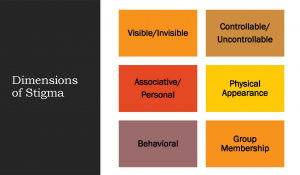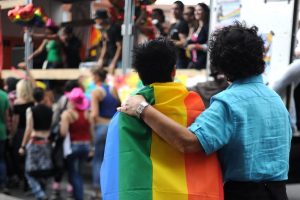9
“Stigma is a process by which the reaction of others spoils a normal identity.”
~Erving Goffman (1963), a famous sociologist who studied social stigma
People have numerous identities that influence how they experience their social world. Goffman’s quote here reminds us that the experience of stigma is created by the reactions of others to our identities. In other words, being a sexual minority, an African American, a person with a disability, a woman, or an elderly person in and of itself is not necessarily a negative experience for the person who possesses the identity except when such identities are reacted to negatively by others. Indeed, being the target of discrimination, stereotyping, and prejudice is a painful and sometimes dangerous experience. For example, the stereotype that Black Americans are dangerous has been implicated in the use of excessive force against unarmed Black men and women (e.g., George Floyd and so many others; see full list here). Discrimination experiences take different shapes and forms for various members of social groups given the different types of stereotypes they encounter. Regardless of the type of discrimination, numerous studies have shown that experiencing discrimination is detrimental to the health and well-being of women, African Americans, disabled individuals, obese people, the LGBT community and other stigmatized groups (Pascoe & Smart Richman, 2009).
Learning Objectives
- Define stigmatized identity
- Identify the different dimensions of stigmatization
- Understand the consequences of being the recipient of discrimination
- Describe the situational nature of stigma
- Describe the ways people cope with stigmatized identities
- Explain the costs and benefits of self-protective coping strategies
- Distinguish between self-stigma and public stigma
- Describe microaggressions
Introduction

Numerous groups in society are the targets or recipients of prejudice, discrimination and stereotyping including women, people with disabilities, sexual minorities, ethnic/racial minorities, and people living with mental illnesses. These group members all have a stigmatized identity, which means that they possess or think they possess an attribute or characteristic that conveys a social identity that is devalued in a particular context (Crocker, Major, & Steele, 1998). The specific attributes and characteristics that are devalued vary along several dimensions (Crocker & Major, 1989; see Figure 1) including whether the attribute is visible, controllable, personal or associative as well as whether the characteristic is based on behaviors, physical appearance and/or group membership. For example, you may not know by look at a person whether that person is living with a mental illness, identifies as bisexual, or whether they have a father who is an alcoholic. Thus, these identities are concealable to others while other identities cannot be easily concealed (e.g., age, race). Indeed, some identities are easily concealed because they are associative stigmas, i.e., the stigma is a result of one’s relationship to another stigmatized person (Birenbaum, 1970; Goffman, 1963; Quinn & Chaudoir, 2009) who may not be physically present. For example, having a relative who struggles with alcohol dependence or being the parent of a child with a physical disability are both examines of associative stigmas while being the person who is dependent on alcohol or the person who has a physical disability is a personal stigma.
In addition, some stigmas are also controllable or perceived to be controllable by others. With controllable stigmas, membership is perceived to be volitional and therefore, escapable. For example, many view obesity or practicing Judaism as controllable identities. The public assumes that those who are obese could change their diet to no longer be obese or Jewish people could escape persecution by converting to a different religion. Moreover, some stigma attributes are determined by behavior, appearance or group membership. These stigma dimensions can determine the nature of the prejudice aimed at members of devalued groups. For example, people with stigmas that are perceived to be controllable are often blamed for their position in society. Indeed, research shows that when people believe that obesity is controllable, they have less sympathy and more anger towards obese people (Joslyn & Haider-Markel, 2019).
Though the nature of stigma may vary by the attributes and characteristics of the specific stigmatized identity, members of these groups (regardless of the dimension of stigmatization) are commonly perceived as lower status, and socially excluded or discriminated against. Moreover, these discrimination experiences have downstream consequences for psychological and physical health as well as decision-making (e.g., chosen career). Numerous empirical studies have documented that discrimination experiences are experienced as a form of stress that negative impacts life satisfaction, happiness, general mental health and physical health (see Pascoe & Smart Richman, 2009 for a more thorough review). Moreover, being the target of discrimination can lead people to worry about future experiences of discrimination and thus, minority group members often engage in vigilant coping behaviors, i.e., preparing for future insults or modifying their own behavior to prevent discrimination in the future. For example, African American men try to smile around others to reduce the likelihood that others will perceive them as dangerous (Neel, Neufeld, & Neuberg, 2013). Women may dress in ways to avoid being sexually harassed or discriminated against at work. Unlike privileged group members, stigmatized group members face the additional burden of trying to evade discrimination through their own actions. This vigilant behavior has been proposed as an additional mechanism by which discrimination leads to high levels of stress (Himmelstein, Young, Sanchez, & Jackson, 2015) and sleep problems (Hicken, Lee, Ailshire, Burgard, & Williams, 2013).
SITUATIONAL NATURE OF STIGMA

In social psychology, we emphasize the situational nature of stigma. Not all social encounters give rise to discrimination experiences or expectations of discrimination. Stigma researchers have emphasized that the meaning of one’s identity varies from situation to situation. In a single day, we move through numerous physical spaces and social contexts that change the perceived value of our identities. For example, a gay man may feel as though his sexual identity is valued when he is socializing with his gay male friends at lunch but feel as though his identity is devalued when he is at work where he is the only person who is gay. Having solo status (i.e., being the only person who possess a stigmatized identity in a particular context) is known to trigger concerns about one’s identity being devalued. In an academic setting wherein, women may worry about confirming the stereotype that women are bad at math, these identity threat concerns can impair women’s ability to perform well on an exam related to math ability (Sekaquaptewa & Thompson, 2002). Research also suggests that being around similarly stigmatized others might reduce identity threat concerns. For example, people with stigmatized identities who encounter more people with similar stigmas throughout their day report greater self-esteem (Frable, Pratt, & Hoey, 1998). Moreover, women in who receive peer mentoring from other women also endure longer in male-dominated fields (Dennehy & Dasgupta, 2017). Thus, the presence of similar others can buffer the discomforts of solo status.
STIGMA RESILIENCE AND COPING
Discrimination Attributions. When researchers first started studying stigmatized identity, they assumed that people who possessed stigmatized identities would come to view themselves negatively and thus would view themselves more negatively than those with more privileged identities. Yet, this was not the case. In fact, research studies found that African Americans outscored European Americans on measures of self-esteem. Crocker and Major (1989) proposed that stigmatized group members have strategies to cope with having a stigmatized identity that protect their self-esteem. Discrimination attributions are a prominent strategy that may effectively protect self-esteem. For example, a female applicant who is rejected from their first-choice internship at a prestigious law firm could attribute that rejection to sexism. An African American who is treated rudely by a store manager could attribute the store manager’s behavior to discrimination. These are both examples of interpersonal discrimination because they involve the actions and behaviors of an individual (e.g., the store clerk) or group of individuals (e.g., the partners at the law firm). Attributions can also be made about institutional discrimination when an organization is perceived as treating individuals differently on their stigmatized identity. For example, a student with a physical disability who is unable to reach class on time because the building is not easily wheelchair accessible could attribute this negative experience to institutional discrimination as the university has not created an environment that is sensitive to the needs of students with physical disabilities. Making attributions to discrimination blames negative outcomes and experiences on external factors and thus, protects one’s self-esteem. However, it is not always easy to point unambiguously to discrimination when interpreting negative social experiences.
Some forms of discrimination are subtle, which can make discrimination attributions less accessible or make people judge an event as less severe and thus, not discriminatory. Let’s take the example of microaggressions. Microaggressions are known as the insults, invalidations, and indignities that members of marginalized groups experience in their everyday interpersonal encounters (Sue et al., 2007). These microaggressions can be unintentional as perpetrators are often unaware that their actions have caused harm. Let’s take the example of an Asian American student being asked, “Where are you really from?” by a fellow White American student. This question suggests that the White American student assumed that the Asian American student was not from the United States. This form of American identity denial is commonly experienced among Americans of a bicultural background. Moreover, American identity denial has been linked to greater depressive symptoms and stress (e.g., Albuja, Sanchez, & Gaither, 2019a), but this may depend on whether the identity denial is attributed to prejudice (e.g., Albuja, Sanchez, & Gaither, 2019b). Subtle experiences of discrimination may be harder to deflect if they are not recognized as discrimination.
While making discrimination attributions may prevent stigmatized group members from adopting a negative view of themselves in the short term, such attributions may be costly in the long term as minority group members become increasingly aware of the negative attitudes that others have about their social group, i.e., public stigma. Having a high level of discrimination awareness may make one’s environment feel uncontrollable and scary. One way to regain a sense of autonomy may be to confront the prejudice one encounters in the environment. Confronting prejudice refers to interpersonal interactions wherein a person reprimands or otherwise condemns the prejudice behaviors of others. Some research suggests that ethnic minorities who report more frequently confronting discrimination also report greater autonomy and psychological well-being (Sanchez, Himmelstein, Young, Albuja, & Garcia, 2016). In addition, confronting discrimination serves the function of reducing stereotypic behaviors in those who are confronted (Chaney & Sanchez, 2018, Chaney, Sanchez, Alt, & Shih, 2021), Taken together, these findings suggest that confronting promotes the autonomy and well-being for recipients of discrimination, while simultaneously reducing the likelihood of encountering prejudice in the future (by curbing biased behavior; Chaney, Young, & Sanchez, 2015). Nonetheless, stigmatized individuals may be reluctant to confront prejudice as it risks social repercussions (e.g., being labeled a complainer or worse). Moreover, confronting may place an additional burden on targets: to not only endure discrimination but to combat discrimination themselves.
Ingroup Comparisons. Making ingroup social comparisons is another stigma-coping strategy that has been proposed to protect the self-worth of stigmatized group members (Crocker & Major, 1989). Because stigmatized group members experience discrimination and thus, are often precluded from positions of high status or power, they likely have fewer resources and more disadvantages than those who are not stigmatized group members. Comparing themselves to others in more privileged environments could be painful or otherwise aversive. Thus, making comparisons with similar others may protect one’s self-concept. Imagine a low-income college student who is managing a full-time job while attending college. She could compare herself to her high-income classmate who does not have to worry about paying her own bills or she could compare her situation to other students who are in a similar financial situation. While self-protective, ingroup comparisons may not always provide accurate information, and they may obscure discrimination awareness. For example, imagine a female engineer only compared her salary to other female engineers instead of comparing her salary to her male colleagues. She may be unaware that she was systematically underpaid in her office if she were to focus entirely on ingroup comparisons. Thus, ingroup comparisons may serve to maintain social inequalities.
Selective Values. Stigmatized group members may protect their self-worth by valuing the domains (e.g., the activities, occupations, or characteristics) in which their group is believed to succeed while avoiding those domains in which their group is expected to perform poorly (Crocker & Major, 1989). If, for example, women believe that they are not supposed to be good at math, not caring about math is an effective method to detach their self-worth from their math performance. To avoid the discrimination and the aversiveness of solo status environments, disadvantaged group members may avoid careers where they do not see similar others. Unfortunately, this often means avoiding high-paying occupations. For example, women are underrepresented in several occupations in Science, Technology, Engineering and Mathematics (STEM) fields. Some have argued that women and girls feel like they do not belong in STEM and may avoid STEM fields because they wish to avoid the negative stereotypes and expectations about their performance in STEM domains. Devaluing fields in which there are negative expectations for one’s group may serve to protect one’s self-esteem, but such behaviors unnecessary limit the aspirations of stigmatized group members and once again, serve to reinforce the status quo.

Concealable Identities. For people who have concealable stigmatized identities, they strategically hide their identities to protect themselves from social rejection. Some disabilities, medical conditions, mental illnesses, or other identities such as being a survivor of abuse, a sexual minority, or having family members with addictions are considered concealable identities because these identities may be unknown to others unless disclosed to others. People may conceal their stigmatized identities to avoid discrimination or to avoid being the target of stereotyping. At the same time, concealment can be psychologically taxing as hiding one’s identity can be effortful and stressful (Pachankis, 2007). Moreover, concealment may limit one’s ability to authentically connect with others. Disclosure can also be risky or in some cases, dangerous. For example, disclosing one’s identity may make a person vulnerable to hate crimes or other forms of mistreatment such as employment or housing discrimination. Thus, revealing one’s stigmatized identity may be a difficult decision-making process. Yet, when disclosures go well, they can have numerous psychological benefits. When people with concealable identities have positive disclosure experiences, they report high self-esteem, and greater psychological and physical health (see Chaudoir & Fisher, 2010 for review). Unlike those with privileged identities, those who have concealable stigmas must carefully navigate concealment and disclosure in order to assess whether situations are physically and psychological safe for them to share their identities with others.
Self-stigma. Though there are many methods of protecting one’s self-worth from the negative views of others, some stigmatized group members have high self-stigma or internalized negative attitudes about their stigmatized identity. Indeed, some individuals come to believe the negative cultural beliefs that others hold about their identities. Those who are higher in self-stigma may be particularly at risk for poor mental health. For example, research shows that people living with mental illnesses who are high in self-stigma are at higher risk of lower self-esteem, greater psychiatric symptoms and difficulties with social relationships and greater feelings of hopelessness, yet they are simultaneously less likely to seek and sustain mental health treatment than those low in self-stigma (Yanos, DeLuca, Roe & Lysaker, 2020). This work suggests that developing effective coping strategies is only part of the solution for improving the well-being of stigmatized group members. Instead, a better solution might be to shift cultural attitudes about stigmatized group members to reduce prejudices against these groups.
SUMMARY
This chapter has reviewed the various dimensions of stigmatization as well as the numerous ways that people with stigmatized identities maintain their self-worth in the face of discrimination. Moreover, this chapter has explored the consequences of some of these strategies suggesting that the methods that can protect self-worth (e.g., discrimination attributions, concealment) simultaneously put stigmatized individuals at long term risk for other negative psychological outcomes (e.g., higher levels of vigilance and stress). Moreover, this chapter emphasized how stigma is situationally-defined such that the perceived value of one’s identity shifts depending on our social surroundings. Because stigma is created by the negative reactions of others to otherwise normal identities, the most powerful weapon against stigmatization is to facilitate more positive attitudes towards these attributes and group identities.
Text Attribution
The possession of an attribute or characteristic that is devalued by others in particular contexts.
A stigma that results from being associated with someone who has a stigmatized identity such as having a spouse with a mental illness.
A stigma that results from one’s own attributes or characteristics such as a personal history of substance use.
Possessing an attribute or characteristic that is devalued by others and viewed to be escapable and thus, membership is perceived to be volitional.
When stigmatized group members protect themselves against discrimination monitoring or modifying behavior.
The condition of being the only person who possesses a stigmatized identity in a particular context.
Insults, invalidations, and indignities that members of stigmatized groups experience in their everyday interpersonal encounters
The negative attitudes that the public holds about their stigmatized identity.
Interpersonal interactions wherein a person corrects or otherwise condemns the prejudice behaviors of others.
The internalized negative attitudes that a stigmatized person holds about their stigmatized identity.
